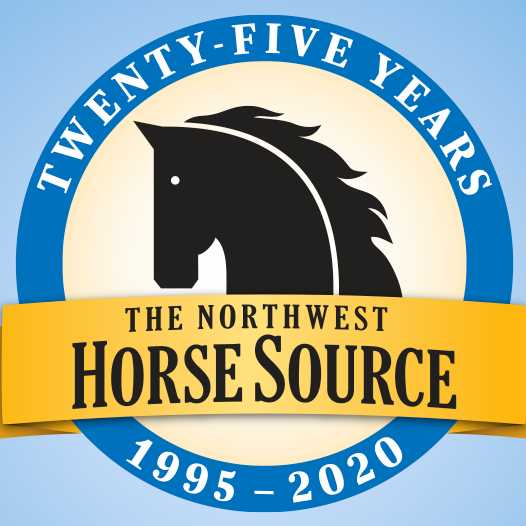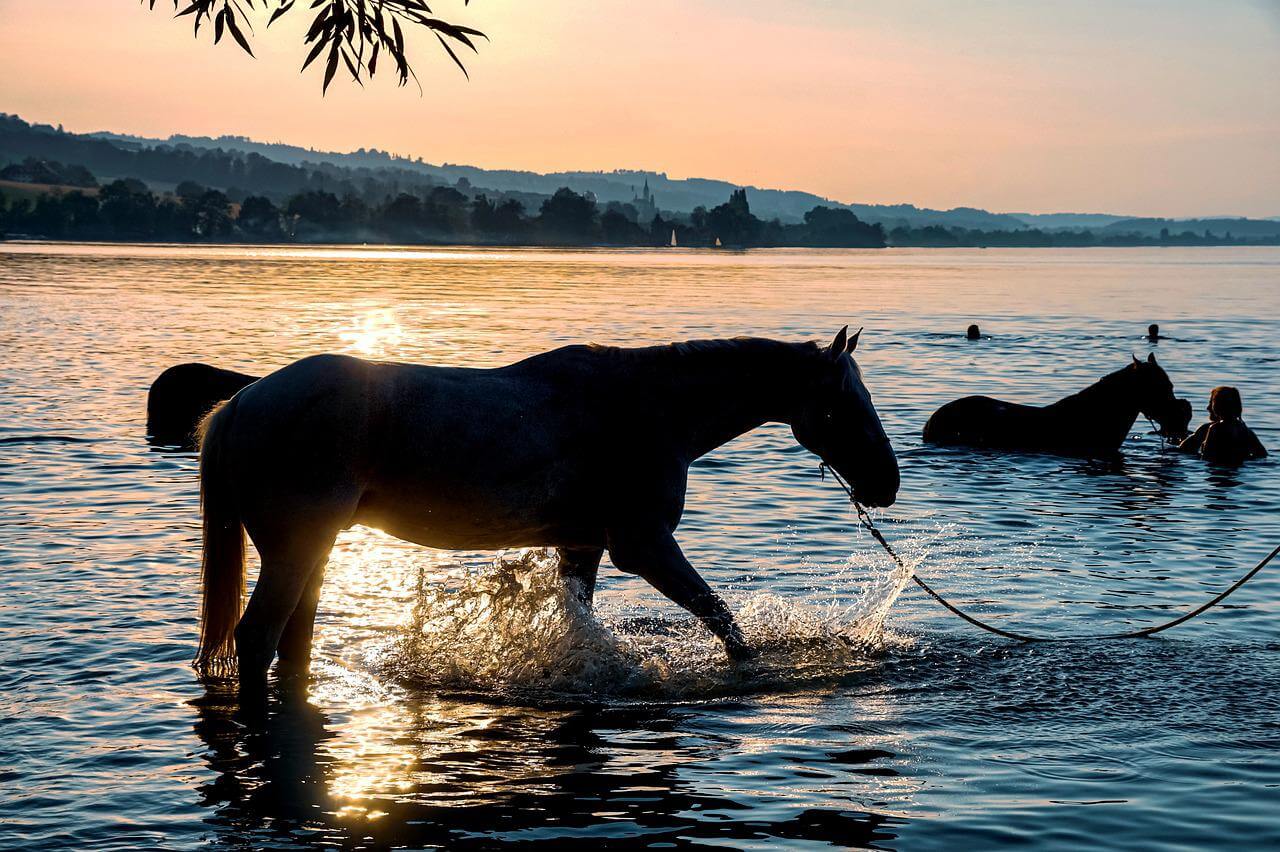By Tony Hawkins, DVM, Valley Vet Supply Technical Service Veterinarian
In Part 1 of this series, we discussed heat stress in dogs, which are very prone to overheating. Now, we’re moving on to horses.
Horses are very proficient sweaters, making them some of the most efficient animals at cooling themselves – but, they are still at risk for heat stress. There are many ways we can help them sidestep this risk as the temperatures heat up. Below, we cover diminished electrolytes, groups of horses at greater risk, signs of heat stress, and tips to keep your horses safe.
Depleted Electrolytes Through Sweating
Sweating is one of the most efficient ways that animals can cool down, and a horse can sweat up to two to four gallons per hour, which is remarkable. An important point, though, is that horses will lose a lot of electrolytes while sweating, and they can experience electrolyte imbalances with all of the sweating that they do. Even if horses are not in training or being worked, it’s a good idea to incorporate electrolytes into their diet. Doing so will replenish electrolytes, encourage more water intake, and help prevent dehydration.
I do encourage that horse owners add electrolytes to the horse’s feed, not their water, which can make the water taste kind of salty or simply just different from what the horse is used to (meaning less water consumption). When you add it to the feed, you’ll still get the benefit because horses will consume the electrolyte, then drink the fresh water.
Groups of Horses at Greater Risk
Similar to dogs, we have some groups of horses that are at increased risk for overheating. Horses that are overweight, in poor condition, or are senior horses are at increased risk. Also, horses that move or are transported from a cooler climate into a hot climate. If these horses are not given time to acclimate, such as being kept in a cool barn with constant fans, they become at increased risk.
Also at risk are horses with conditions such as PPID (Pituitary Pars Intermedia Dysfunction), known as Cushing’s Disease – the most common hormonal disorder affecting horses and ponies. A PPID horse will often have a thick, non-shedding hair coat. For these horses, it’s important that you clip them a few times throughout the warmer months to keep a short hair coat.
Know the Signs of Heat Stress in Horses
- Watch for visible signs, such as muscle stiffness, lethargy, stumbling and incoordination.
- If your horse stops sweating, that’s a sign they’re getting overheated and you need to stop exercising your horse and get them cooled down right away.
- Increased respiration rate is also a sign – normally, it should be eight to 12, up to 18 respirations per minute, so if a horse gets over 50, that’s very concerning.
- If a horse’s temperature is over 102° Fahrenheit, that’s a sign that they’re overheating. The normal range is 98° to 101° Fahrenheit.
Tips for Keeping Your Horses Safe
- Offer horses continuous access to fresh water and feed electrolytes.
- Understand the horse heat index to help determine if it’s safe to exercise your horse. Simply add the day’s temperature in Fahrenheit, plus the percentage of humidity. So, for example, let’s say it’s 90° outside with 60% humidity. That would be a horse heat index of 150. If you’re in the 120 to 150 range, your horse is OK to exercise. From 150 to 180, there’s a higher risk – light exercise may be allowed, depending on your horse’s acclimation and fitness level. If the horse heat index is over 180, avoid exercising your horse. The risk is too great, unless they’re an elite athlete.
- In the warmer weather, horses definitely need frequent breaks, water and cooling down. To be on the safe side of avoiding heat stress, try to ride during a lower horse heat index.
- Be smart about when you haul horses, and cattle, too. Let’s trailer them during the cool early mornings, evenings or overnight. Keep all windows and vents open to get as much air flow through the trailer as you can. Adequate shavings and mats will create a barrier between the hot road and the horse.
- If you have a long trailer ride, you need to stop at least every four hours. Get your horse out for 20 to 30 minutes and offer access to fresh water, maybe even a small meal. Walk them around and make sure they’re cooled off. If you need to, hose them down.
- Schedule feeding around a horse’s training schedule. Horses are like cattle in that they produce a lot of heat through digestion. Because of this, we should avoid combining the added heat being produced through muscular activity, exercise and digestion to cause overheating.
- Feed three to four hours prior to exercise, or wait at least two hours after exercise to feed your horse.
- Install a fan in each horse’s stall. As you know, stalls can get very hot if they’re closed up, so putting a fan in every stall can go a long way. As an added benefit, moving air from a livestock fan will help keep the flies and mosquitoes away.
- Leave barn windows and doors open to increase ventilation and air movement as much as possible.
- If your horses are out on pasture, shade from a simple lean-to will keep them out of the sunshine.
- To protect horses from sunburns and some of the cancers that can develop because of them, look into fly sheets or fly masks that can provide up to 90% UV protection. This is especially important for your light-colored horses and Paints, which can be more prone to sunburns.
- If you exercise your horse, it’s important to cool them down. Their muscles can accumulate a lot of heat during training, and if we just stop, then that heat becomes trapped in that musculature. Sweating cools the skin surface; we need to keep that blood flowing so that cool blood can be transported back to the muscles to cool them off.
- Walk your horse for 10 to 15 minutes. After that, let them drink a small amount of water.
- The American Association of Equine Practitioners recommends applying cool water to your entire horse, stating, “Spend time hosing his largest muscle areas and the largest and closest-to-the-surface blood vessels, the jugular vein in the neck and the saphenous vein on the inner thigh. Doing this cools the body faster.”
I hope this information will help you keep your horses safe, as we round out the warmest months of the year. Read Part 1, Keeping Your Dogs Safe and Part 3, Managing Cattle in Warm Weather. Visit ValleyVet.com to learn more.
About Valley Vet Supply
Valley Vet Supply was founded in 1985 by veterinarians to provide customers with the very best animal health solutions. Building on over half a century of experience in veterinary medicine, Valley Vet Supply serves equine, pet and livestock owners with thousands of products and medications hand-selected by Valley Vet Supply Technical Service veterinarians and team of industry professionals. With an in-house pharmacy that is licensed in all 50 states, and verified through the National Association of Boards of Pharmacy (NABP), Valley Vet Supply is the dedicated source for all things horse, livestock and pet. For more information, please visit ValleyVet.com.
This AHP Newsgroup release is archived on the AHP website at www.americanhorsepubs.org/newsgroup

News from the horse industry. Sharing today’s information as it happens. The Northwest Horse Source is not responsible for the content of 3rd party submissions.






